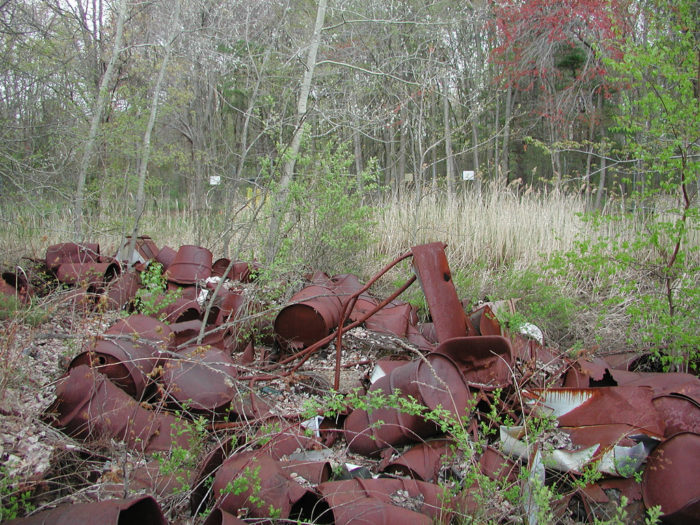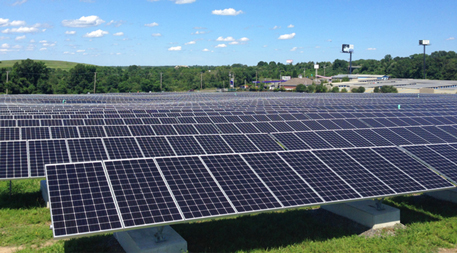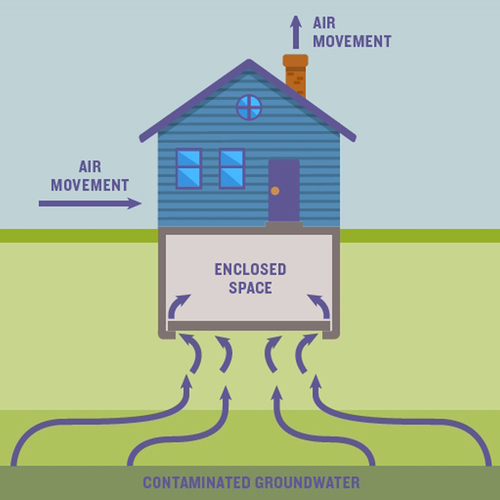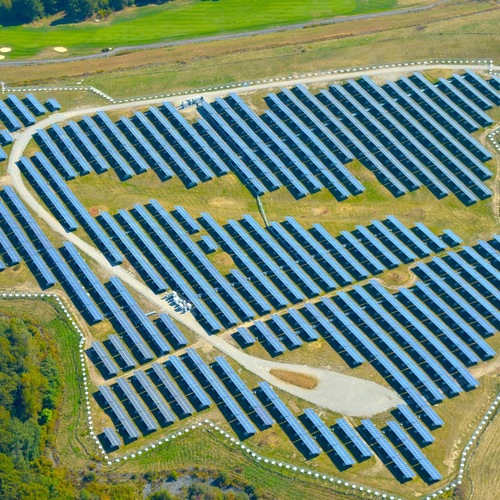
This post originally appeared at Ensia.
When Charles Schmid first moved to Bainbridge Island, Washington, in 1970, the Wyckoff Company was still stripping bark from timber and treating the logs with creosote, an oily liquid processed from coal tar. The waterfront factory had used similar wood-preservation methods dating back to the early 1900s, when it began producing materials for some of the world’s largest infrastructure projects, including the Panama Canal, Great Northern Railroad, and San Francisco’s wharfs.
In fact, Schmid used to pick up free bark from Wyckoff. “Everything seemed fine,” he recalls. But by the 1980s, he began to learn about contamination at and around the site — pools of creosote, fish with lesions, shellfish too toxic to eat. The emerging news spurred him and other members of this island community, a short ferry ride from Seattle, to push for cleanup.
Fortunately for Schmid and his neighbors, seven years earlier the U.S. Congress had passed the Comprehensive Environmental Response, Compensation and Liability Act (CERCLA), which created a pool of money known as the Superfund that could be used to clean up such sites.
In 1987 the site was added to the Superfund National Priorities List (NPL) a designation reserved for areas where contamination poses a significant threat to human health or the environment and demands a concerted, long-term, federally coordinated remedy.
Today, most of the 50-plus acres of polluted property have been cleaned up. It’s also taken on a new life as Pritchard Park — complete with wooded trails, views across Puget Sound of downtown Seattle and Mount Rainier, and a man-made sandy beach — thanks to $8 million in government grants and private funds raised by community members, including Schmid, to buy the land. Since most of the island’s waterfront is privately owned, this new public parkland is particularly special.
“It’s so important for people to get to the water,” Schmid says as he shows me around the site. “Kids always want to be in the water.”
Polluted sites are being restored
Pritchard Park is just one illustration of efforts across the U.S. to put contaminated sites back to use for communities — as parks, playing fields, workplaces, homes, shopping centers, even renewable energy projects.
“EPA places a high priority on land revitalization as an integral part of its Superfund cleanup mission,” says U.S. Environmental Protection Agency spokesperson Enesta Jones. “Superfund cleanups have allowed hundreds of communities to reclaim formerly contaminated Superfund sites for protective and productive uses.”
Commercial uses tend to be the most popular: Such redevelopment can yield new jobs and tax dollars. Based on information collected at 487 of the 888 Superfund sites in reuse, the EPA estimates that cleaned sites supported approximately 6,600 businesses in 2017 with ongoing operations employing more than 156,000 people and generating annual sales of $43.6 billion.
Lessons are emerging from Superfund reuses to date, including the importance of involving the local community and creating a vision for reuse early in the cleanup process. Warnings also abound about what can go wrong during and after redevelopment, especially if inadequate attention is given to remediation.
Since passage of CERCLA in 1980, more than 1,700 sites around the U.S. have been listed on the NPL. As of late February, 399 sites have been fully cleaned up and deleted from the list. As more sites are added to the Superfund list, and as more sites on the list are cleaned up, environmental experts hope past experience will bring more efficiency and success to future repurposing projects.
Matching cleanup and use
Some 20 miles south, as the seagull flies, from Pritchard Park, another Superfund reuse story is unfolding.
Starting in the late 1800s, Tacoma’s Thea Foss Waterway was part of a massive hub for shipbuilders, oil refiners, chemical manufacturers, and the like. The industries left the soil, groundwater, and bay sediment laden with pollutants including heavy metals, phthalates, and polychlorinated biphenyls (PCBs). The EPA added the site to the Superfund in 1983.

Reuse considerations were incorporated into many aspects of the site’s cleanup, according to the EPA. Today, marinas, apartments, and businesses line the waterway, and buildings, paved surfaces, and other structures hold remaining contamination in place. And, in designing the sediment cleanup plan, coordination with property owners ensured that water depths resulting from dredging and capping efforts were compatible with future land uses.
Igor Linkov, a risk and decision scientist with the Army Corps of Engineers, notes that site use decisions are not always considered in developing cleanup strategies. The end result can be too little clean up — or too much, says Linkov, speaking based on his prior consulting experience and not representing government views.
“In many cases, efforts end up overly conservative and can result in wasted resources,” he adds. “It doesn’t make sense to clean up a site to the level that’s appropriate for a kindergarten if it is going to be a parking lot.”
A growing set of tools can help stakeholders explore how the cleanup of decades-old pollution can go hand-in-glove with reuse of the land. The EPA’s Superfund Redevelopment Initiative includes information for selecting cleanup remedies that are consistent with a site’s anticipated reuse. The EPA also leverages administrative and legal measures, or so-called institutional controls, to reduce toxic exposures by ensuring a change in land use is not allowed unless a state or federal environmental agency reviews and orders any necessary further cleanup.
Under the Superfund law, land targeted for residential use must live up to a different standard than if it is intended for, say, industrial use. In practice, suggests Mathy Stanislaus, former assistant administrator at the EPA’s Office of Land and Emergency Management, designations tend to be generic — identifying the future use only as industrial, commercial, or residential. These categories can cover significantly different kinds of development, especially when considering potential toxic exposures. A commercial use, for example, may turn out to be anything from a daycare or library to a parking lot. So, when a specific end use has been determined, noted Stanislaus, it should be specifically considered.
No need to wait
Delisting a Superfund site often takes many decades. Thankfully, experts note, reuse generally doesn’t need to wait that long. “In ideal circumstances, you can do the remedial action with components of redevelopment,” says Stanislaus.
That dual effort is underway at the Wyckoff site, which remains on the NPL. A stroll northeast down the Pritchard Park beach ends at a barbed wire fence set atop a steel wall and adorned with warnings to keep away and to not to eat the crab, bottomfish, or shellfish from these waters. A faint petrochemical smell fills the air, a stark reminder that another 650,000 gallons of creosote and other toxic chemicals persist in the ground beneath the former facility.
“There’s still a long way to go,” says Schmid. “This stuff doesn’t give up.”
Inside the fence are the final 5-plus acres (2-plus hectares) of land with the heaviest contamination. This area, which juts out into Puget Sound, is probably also the site’s most prime real estate. Schmid imagines kids flying kites out here one day.
Given the extent of the pollution and the constraints on money and manpower, that day is at least another decade away, according Helen Bottcher, the EPA project manager of the site. But plans for how the final piece of waterfront property will be incorporated into the park are on the drawing board, replete with accents that could include a wedding venue, a giant windmill, or a peace pagoda.
Protect against injustice
Among the adverse consequences to be alert for related to Superfund redevelopment is gentrification. Overall, 15% of the more than 50 million people who reside within three miles of a Superfund site live below the poverty line, according to a 2015 EPA report.
“If you come in and say you’re helping the community and then the community can’t afford to live there anymore, that’s a big issue,” says Katherine Probst, an environmental policy consultant with expertise in Superfund. The promise, for example, of a cleaner Gowanus Canal in Brooklyn — a Superfund site in a historically low-income area — has prompted development and driven up rental costs in the surrounding neighborhood.
Debbie Chizewer, an environmental advocacy lawyer at Northwestern University Pritzker School of Law, is working with a low-income community in East Chicago on the future of polluted land targeted for redevelopment.
“Since many Superfund sites are in low-income communities of color, I think it’s exceptionally important to protect against more environmental injustice,” says Chizewer. “You need to make sure the reuse is not something that threatens the community’s health.”
The reuse plan is still unclear for the former housing complex and school, which were vacated due to lead and arsenic contamination. Some members of the community would like to one day call the site home again.
“There’s a sense of loss in this community. Many neighbors have had to move out, leaving families separated,” Chizewer says. “On the other hand, there are people who don’t want to have anything like this happen to another family because their kids have ADHD and other problems associated with lead exposure.”
Discussions so far have raised other possibilities for the site, including bus storage or a solar energy farm. Chizewer says she fears the former idea could bring yet more air and noise pollution to the vulnerable neighborhood. She is, however, a fan of the latter idea. “Then the adjacent residents could get the benefits of the energy created on the site,” she says.
Energy opportunities
The East Chicago site is not alone in attracting the attention of energy developers. In New Bedford, Massachusetts, more than 5,000 solar panels are visible from a highway interchange. The array sits on Sullivan’s Ledge — once a granite quarry and then a town landfill, where electrical transformers, fuel oil, metal and scrap rubber piled up. The soil, sediment, and groundwater were left heavily polluted, leading to the site’s placement on the Superfund NPL in 1984.
Solar farms are becoming an increasingly popular choice for Superfund sites, in particular those too contaminated to be sufficiently cleaned for residential or commercial reuse. Technological advances in panel mounting and framing also mean that solar panel systems can now have minimal impact on the integrity of landfill covers — making the use a more feasible option. The cap at this New Bedford site wouldn’t have supported the weight of a commercial building, according to John DeVillars, chairman of Boston-based BlueWave Solar, which helped with the project. But it can support the panels.

Around 2010, Stanislaus partnered with the U.S. Department of Energy’s National Renewable Energy Laboratory to map Superfund sites with high opportunities for renewable energy development. The effort was part of the RE-Powering America’s Land Initiative, which encourages renewable energy on already developed or degraded land instead of green space.
“Our company and every other solar developer company has chewed up too much farmland and forest land,” says DeVillars.
The 1.8-megawatt solar array produces enough energy to save New Bedford about 30% on its municipal electricity bills and to offset carbon dioxide emissions from electricity use of more than 226 homes.
“Sullivan’s Ledge is a great example of our city turning an environmental liability into an environmental asset,” says Jonathan Mitchell, the city’s mayor.
Symbols of hope
EPA administrator Scott Pruitt has called for accelerating the cleanup and reuse of Superfund sites across the country. “Today’s redevelopment list incorporates Superfund sites ready to become catalysts for economic growth and revitalization,” Pruitt said in a January statement with the release of a list of 31 Superfund sites he deemed prime candidates for reuse.
Environmental policy experts generally agree that efforts to revitalize formerly contaminated land can generate benefits. However, some are concerned that too much attention on redevelopment could compromise the key goal of the Superfund program — to protect public health and the environment.
“There are still over 100 sites where human health is not under control,” says Probst. “I would argue that redevelopment is not the most important aspect of this program.”
Critics’ concerns are amplified by a proposed budget from the Trump administration that would not increase funds for the Superfund program despite Pruitt’s pledges of an increased focus. However, Pruitt has claimed that private investment in cleanup and reuse can fill funding gaps.
With foresight, preparation and patience, some of the country’s past environmental nightmares can well become symbols of hope for the future.
“You need to understand that it is going to be a long haul,” advises Bottcher, the Wyckoff site project manager. “The earlier the community can start planning and envisioning how sites will be used in the future, it helps everyone. It helps the EPA make smart decisions that would be compatible with that future use, and it helps the community or property owner to raise funds for that redevelopment.”
The transformation of the Wyckoff site is a particularly poignant example of turning trouble to hope. During World War II, while workers at the creosote factory were excluded from the draft — the operations were considered too vital to national defense — more than 200 residents of Bainbridge Island became the first Japanese Americans exiled to internment camps. A short walk from the factory was the dock where they were ferried away. Now a memorial wall on this section of the Superfund site commemorates the history of the exclusion.
In a recommendation report for the Superfund site, the Pritchard Park Design Advisory Committee, on which Schmid served, recognized the dual potential of the chosen reuse: “The park represents the opportunity for healing and restoration of two wrongs from the past — one to the social fabric of the community, the other to the land itself.”
Lynne Peeples is a Seattle-based science journalist specializing in the environment and health.
Weekly Newsletter
Get building science and energy efficiency advice, plus special offers, in your inbox.















0 Comments
Log in or create an account to post a comment.
Sign up Log in